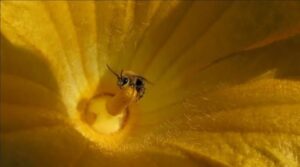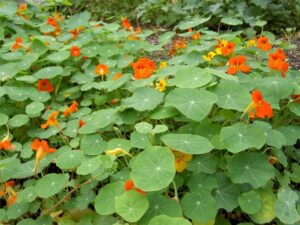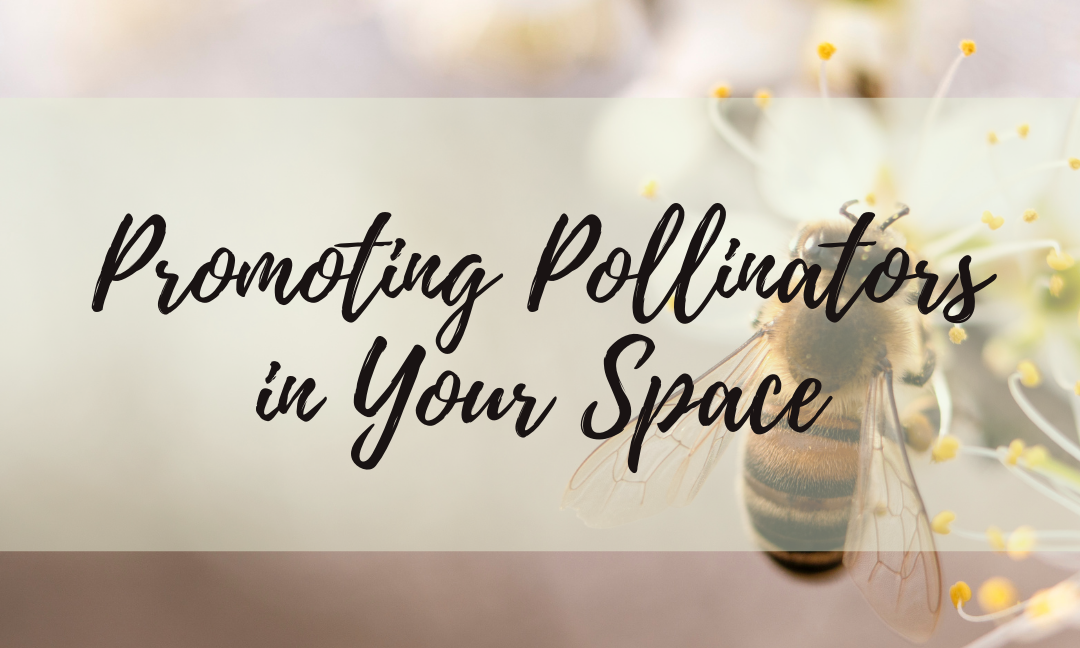Written by: Johnathan Lin
Pollinators are the most important part of an ecosystem; they’re the ones who promote growth through cascading effects that trickle up and down the food chain. Gardens are a great place for pollinators.
Ontario is home to about 400 different species of bees alone, and 20 different moths and butterfly species. Bees specifically are supposed to produce one in every three bites of food we eat. (Meet Ontario’s Pollinators | Ontario Agricultural College). Although over the years, colonies of bees have been dying off and groups are concerned about the consequences of losing a big part of our food supply, along with other consequences that come with losing any amount of pollinators.
 We need to protect both wild and managed bees from decline. The urban areas have intruded on what would be flower fields and plants normally pollinated and needed by bees. By restoring the diversity and spaces for plants and flowers, we can bring back and protect bees from colony collapses, disease, and predators.
We need to protect both wild and managed bees from decline. The urban areas have intruded on what would be flower fields and plants normally pollinated and needed by bees. By restoring the diversity and spaces for plants and flowers, we can bring back and protect bees from colony collapses, disease, and predators.
Having your own garden is a riveting experience. You’re growing your own food as well as helping the environment by protecting at-risk species from harm, and in return they help the growth of your plants (“Pollination”). It’s a symbiotic relationship, and if the bees are managed, then you have yourself a supply of honey. Obviously that takes some degree of knowledge in bees and handling, but I believe the long term benefit is great. It’s not an unknown fact that the consistency, flavour, and sweetness are heavily influenced by the species of flowers and plants the bees pollinate and collect nectar from (Ekasetya). Having bees or even other pollinators sounds like a fun passion project. If you’ve lost interest in nature recently or have experience in biology or zoology maybe try beekeeping? Let us know how it turns out!
There are tons of benefits outside of having them near your plants. Pollinating animals directly impact what you use and see. Bringing us countless fruits, vegetables, and nuts, ½ of the world’s oils, fibers and raw materials; prevent soil erosion, and increase carbon sequestration (“About Pollinators”). Plants and pollinators contribute more than just materialistic things; they provide you with stunning flowers and plants in a variety of they give you beautiful flowers and plants all with unique colours, shapes, designs, and textures. We often take nature for granted when we’re chasing our futures. It’s good to stop and smell the roses.
Pollinators are a great big part of our ecosystems. They sustain life throughout the world pollinating, and outspread plant seeds. They’ve been providing our food for over hundreds of millions of years, as they were some of the first colony based insects. Losing even just the diversity in pollinators would affect the amount of plants pollinated. Specific species target or have preferences to specific flowers which makes even losing one species impactful.
Here are some ways to help protect local pollinators. Perhaps you’ll find that you love those little buzzing bees ,butterflies or any other pollinators you might like keeping.
If you plan on having pollinators in your area, provide some space for them whether that be a pile of sticks, a nice house, apiary, or even a birdhouse, or whatever is easiest for you. Just as long as you know what kinds of pollinators are in your area. And if you’re unsure, you can always use a link from one of our previous posts about pollinators here to learn more about the pollinators in your area. Be sure to use native plants and not exotic plants as native insects typically won’t pollinate those.
 This next one is a MUST, never use pesticides on your plants. Pesticides, especially insecticides, a group pesticides specifically target at insects, kill a large assortment of insects or larvae, and are the cause of mass die offs of insect species in many places around the world (“New Report Highlights 10 Protected Species Endangered by Pesticides”). Keep general use pesticides off your plants and try to supplement them with other methods such as biocontrol. Biocontrol which is in summary introducing natural predators to pests, although in my opinion, this next option is the better option (Organic Pesticides | Making Use of Nature). Polyculture is based on the natural processes of plants where they produce chemicals to defend against pests (Organic Pesticides | Making Use of Nature). Polyculture involves having plants and a variety of them to protect each other with their natural defenses. These defenses range from generating terrible smells, calling natural predators to kill the pests, or excessing stimulation, which basically just gives the pests too much caffeine causing them to overload and pass out (Plant Defense Mechanisms | Boundless Biology). This of course only affects insects and wouldn’t hurt a healthy person.
This next one is a MUST, never use pesticides on your plants. Pesticides, especially insecticides, a group pesticides specifically target at insects, kill a large assortment of insects or larvae, and are the cause of mass die offs of insect species in many places around the world (“New Report Highlights 10 Protected Species Endangered by Pesticides”). Keep general use pesticides off your plants and try to supplement them with other methods such as biocontrol. Biocontrol which is in summary introducing natural predators to pests, although in my opinion, this next option is the better option (Organic Pesticides | Making Use of Nature). Polyculture is based on the natural processes of plants where they produce chemicals to defend against pests (Organic Pesticides | Making Use of Nature). Polyculture involves having plants and a variety of them to protect each other with their natural defenses. These defenses range from generating terrible smells, calling natural predators to kill the pests, or excessing stimulation, which basically just gives the pests too much caffeine causing them to overload and pass out (Plant Defense Mechanisms | Boundless Biology). This of course only affects insects and wouldn’t hurt a healthy person.
Ecosystems heavily rely on pollinators for producing new plants and for us producing consumer goods whether that be food, oils, cotton, etc. We can do more to protect pollinators in Ontario, even the small changes in your life could help a lot. So, if you’re interested, get out there and go promote some pollinators!
Work Cited
“About Pollinators.” Pollinator.Org, https://www.pollinator.org/pollinators. Accessed 12 June 2021.
Ekasetya, Laura. “Why Honeys Taste Different and How You Can Learn to Appreciate Them.” Lurie Garden, 14 Oct. 2016, https://www.luriegarden.org/2016/10/14/appreciate-honeys-variety/.
Meet Ontario’s Pollinators | Ontario Agricultural College. https://www.uoguelph.ca/oac/news/meet-ontarios-pollinators. Accessed 13 June 2021.
MacRae, Maria, and Sarah Coulber. Gardening For Pollinators. Canadian Wildlife Federation, 11 June 2021, https://cwf-fcf.org/en/resources/downloads/booklets-handouts/polle.pdf.
Native Plants For Pollinators. Credit Valley Conservation, 11 June 2021, https://cvc.ca/wp-content/uploads/2017/04/17-uo-nativeplantsforpollinators-booklet-v8-web.pdf.
“New Report Highlights 10 Protected Species Endangered by Pesticides.” Center for Biological Diversity, https://biologicaldiversity.org/w/news/press-releases/new-report-highlights-10-protected-species-endangered-pesticides-2019-10-30/. Accessed 12 June 2021.
Organic Pesticides | Making Use of Nature. https://www.foodunfolded.com/article/pesticide-alternatives-organic-farming. Accessed 12 June 2021.
Pesticide Impact on Wildlife Ecology – Pesticide Environmental Stewardship. https://pesticidestewardship.org/non-target/pesticide-impact/. Accessed 12 June 2021.
Plant Defense Mechanisms | Boundless Biology. https://courses.lumenlearning.com/boundless-biology/chapter/plant-defense-mechanisms/. Accessed 12 June 2021.
“Pollination.” Native Plants and Ecosystem Services, https://www.canr.msu.edu/nativeplants/pollination. Accessed 12 June 2021.
Pollinator Friendly Garden – Landscape Ontario. https://landscapeontario.com/pollinator-friendly-garden. Accessed 12 June 2021.
Schneider, Dan, and Peter Paulter. “Butterfly and Moth Guide.” ON Nature Magazine, 2 Nov. 2009, https://onnaturemagazine.com/butterfly-and-moth-guide.html.
The Honey Bee | All About Ontario Honey. https://www.ontariohoney.ca/educators/the-honey-bee. Accessed 12 June 2021.


I simply could not go away your website prior to suggesting that I actually loved the standard information a person provide in your guests? Is going to be again frequently in order to check out new posts.